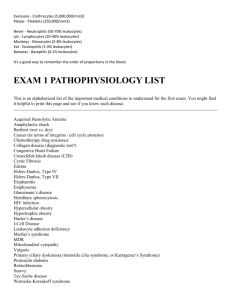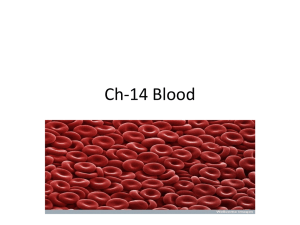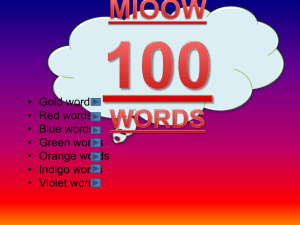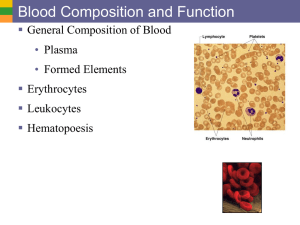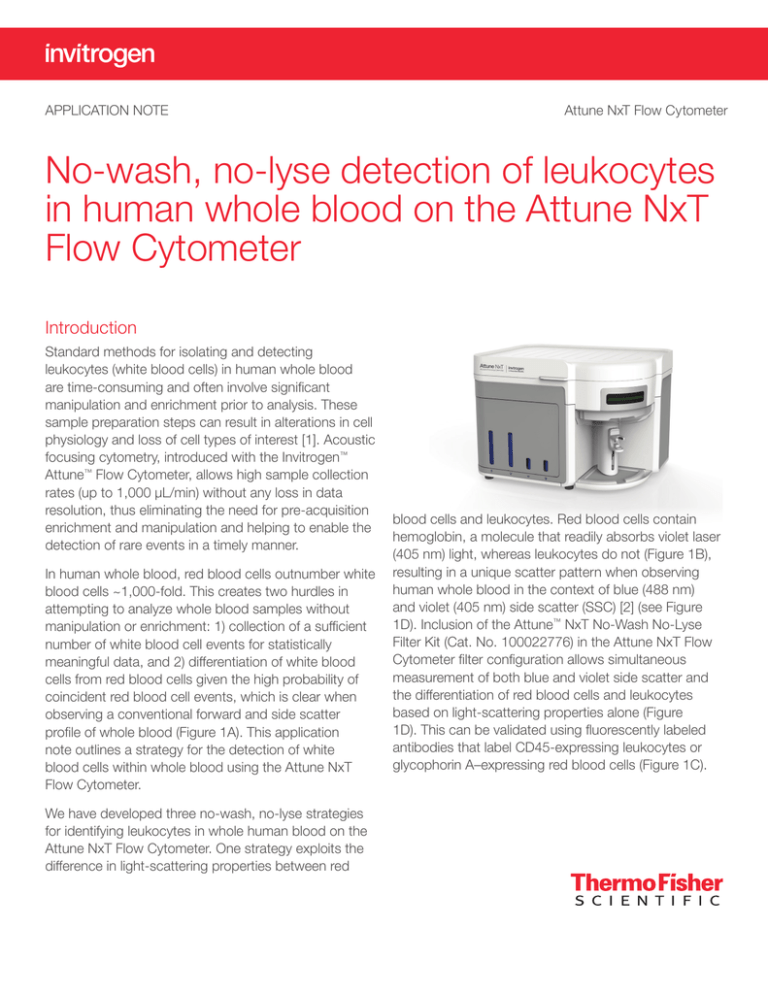
APPLICATION NOTE
Attune NxT Flow Cytometer
No-wash, no-lyse detection of leukocytes
in human whole blood on the Attune NxT
Flow Cytometer
Introduction
Standard methods for isolating and detecting
leukocytes (white blood cells) in human whole blood
are time-consuming and often involve significant
manipulation and enrichment prior to analysis. These
sample preparation steps can result in alterations in cell
physiology and loss of cell types of interest [1]. Acoustic
focusing cytometry, introduced with the Invitrogen™
Attune™ Flow Cytometer, allows high sample collection
rates (up to 1,000 µL/min) without any loss in data
resolution, thus eliminating the need for pre-acquisition
enrichment and manipulation and helping to enable the
detection of rare events in a timely manner.
In human whole blood, red blood cells outnumber white
blood cells ~1,000-fold. This creates two hurdles in
attempting to analyze whole blood samples without
manipulation or enrichment: 1) collection of a sufficient
number of white blood cell events for statistically
meaningful data, and 2) differentiation of white blood
cells from red blood cells given the high probability of
coincident red blood cell events, which is clear when
observing a conventional forward and side scatter
profile of whole blood (Figure 1A). This application
note outlines a strategy for the detection of white
blood cells within whole blood using the Attune NxT
Flow Cytometer.
We have developed three no-wash, no-lyse strategies
for identifying leukocytes in whole human blood on the
Attune NxT Flow Cytometer. One strategy exploits the
difference in light-scattering properties between red
blood cells and leukocytes. Red blood cells contain
hemoglobin, a molecule that readily absorbs violet laser
(405 nm) light, whereas leukocytes do not (Figure 1B),
resulting in a unique scatter pattern when observing
human whole blood in the context of blue (488 nm)
and violet (405 nm) side scatter (SSC) [2] (see Figure
1D). Inclusion of the Attune™ NxT No-Wash No-Lyse
Filter Kit (Cat. No. 100022776) in the Attune NxT Flow
Cytometer filter configuration allows simultaneous
measurement of both blue and violet side scatter and
the differentiation of red blood cells and leukocytes
based on light-scattering properties alone (Figure
1D). This can be validated using fluorescently labeled
antibodies that label CD45-expressing leukocytes or
glycophorin A–expressing red blood cells (Figure 1C).
Glycophorin A FITC
SSC (blue 488 nm) (x 106)
SSC (violet 405 nm) (x 106)
AB C
FSC (blue 488 nm) (x 106)
FSC (blue 488 nm) (x 106)
CD45 Pacific Orange dye
SSC (violet 405 nm)
SSC (violet 405 nm) (x 106)
DE
SSC (blue 488 nm)
FSC (blue 488 nm) (x 106)
Figure 1. Identification of leukocytes in human whole blood using violet side scatter on the Attune NxT Flow Cytometer. Leukocytes are
outnumbered by red blood cells ~1,000-fold in whole blood and generally require enrichment by red blood cell lysis or gradient centrifugation prior
to analysis. The rapid sample collection rates and inclusion of the Attune NxT No-Wash No-Lyse Filter Kit on the Attune NxT Flow Cytometer allow
identification of leukocytes by scatter properties alone. (A) Using conventional blue 488 nm forward and side scatter does not allow resolution of leukocytes
in whole blood. Backgate analysis using fluorescently labeled antibodies specific for leukocytes (pink) and red blood cells (blue) demonstrates this problem.
(B) Resolution of leukocytes from red blood cells in whole blood is improved by incorporating violet 405 nm side scatter. (C) Backgate analysis using
antibodies against the red blood cell marker glycophorin A and the leukocyte marker CD45 demonstrates the ease of identifying leukocytes in human
whole blood, as opposed to in A and B. (D) Using both violet and blue side scatter allows identification of leukocytes in whole blood. This is corroborated
by the backgate analysis done using the glycophorin A and CD45 labeling depicted in C, which demonstrates the different scatter properties of leukocytes
and red blood cells when using violet side scatter. (E) When leukocytes are gated based on violet light scatter properties, the three main leukocyte cell
populations in human blood are present: lymphocytes, monocytes, and granulocytes.
The second no-wash, no-lyse strategy involves the use
of fluorescent probes or conjugated antibodies that
are specific for markers expressed by red blood cells
or leukocytes. For example, red blood cells express
glycophorin A and white blood cells express CD45.
The expression of these two markers is mutually
exclusive, allowing clear identification of red vs.
white blood cells and exclusion of any red blood cell
coincident events (Figure 2A). A third approach is to
use one of the Vybrant™ DyeCycle™ series of dyes to
label nucleated cells, because mature red blood cells
are anucleate (Figure 3A). Necessary materials and
suggested workflows for both the violet scatter and
fluorescent trigger approaches to the no-wash, no-lyse
identification of leukocytes in human whole blood are
included here.
Materials
•Whole blood collected into heparinized tubes
•96-well plates (optional)
•Flow cytometry tubes
•Gibco™ PBS, pH 7.4 (Cat. No. 10010023)
•Attune No-Wash No-Lyse Filter Kit
(Cat. No. 100022776)*
•Anti-CD45 antibody (e.g., Cat. No. MHCD4530TR)†
•Anti–glycophorin A antibody (e.g., Cat. No.
MHGLA014)†
•Gibco™ RPMI 1640 Medium (Cat. No. 11875119)‡
•Vybrant DyeCycle stain (e.g., Ruby,
Cat. No. V10309)‡
•Attune NxT Flow Cytometer
No-wash, no-lyse protocols
Violet side scatter
1.Turn on the instrument; run startup and
performance test scripts as normal.
2.Insert the Attune NxT No-Wash No-Lyse Filter Kit
components into appropriate locations. VL-1 will
serve as your violet side scatter channel (this step
must be done after running the performance test).
3.Create a new experiment and a sample workspace
containing two dot plots. See Figures 1D and 1E for
the recommended gating strategy.
––Plot A: blue SSC (x-axis) vs. violet SSC (y-axis),
both in log scale
––Plot B: blue FSC (x-axis) vs. violet SSC (y-axis),
both in linear scale
Antibody labeling
1.Turn on the instrument; run startup and performance
test scripts as normal.
2.Create at least 4 samples by pipetting 100 µL of
whole blood into sample vessels (microcentrifuge
tubes, flow cytometry tubes, or wells within a 96-well
plate). Reserve one sample as an unstained control.
Additional control samples will be required if more
than two conjugated antibodies are used to label the
sample.
3.To identify all leukocytes within the sample, label cells
in one tube using an antibody directed against the
surface marker CD45.
4.To identify red blood cells within the sample, label
cells in one tube using an antibody directed against
the surface marker glycophorin A.
5.To differentiate white blood cells from red blood cells
within a single sample, label cells in the last tube
using both the anti-CD45 and anti–glycophorin A
antibody conjugates.
4.Pipet 1 µL of blood into 4 mL of PBS, and acquire
the sample (without recording) on the Attune NxT
Flow Cytometer at a sample collection rate of
≥200 µL/min. Adjust the scatter voltages (blue
FSC, SSC, and VL-1 for violet SSC) so that the
blood populations appear similar to those seen in
Figure 1D.
6.Incubate all labeling reactions for 20–30 min at room
temperature, protected from light. An example of this
approach is shown in Figure 2A, in which anti-CD45
Pacific Orange™ conjugate and anti–glycophorin
A FITC conjugate were used to label the two cell
types. Single-color controls should be included to
adjust instrument voltages and compensation (when
needed) prior to sample acquisition.
5.Once optimal instrument settings have been
determined, acquire and record data from the
sample at a collection rate of ≥200 µL/min.
7.Create a workspace on the Attune NxT Flow
Cytometer software containing two dot plots as
indicated in Figures 2A and 2B:
6.Gate on leukocytes by drawing a polygon gate
around the leukocyte population found on the
diagonal of plot A (example shown in Figure 1D).
7.Using the leukocyte parent gate, three white blood
cell populations can be differentiated from red
blood cells in the sample by scatter properties.
Figure 1E depicts the lymphocyte, monocyte, and
granulocyte populations using this gating strategy.
––Plot A: CD45 (x-axis) vs. glycophorin A (y-axis)
––Plot B: blue FSC (x-axis) vs. blue SSC (y-axis)
Additional plots may be inserted into the workspace
as necessary if additional antibody conjugates were
used to label cells within the sample.
8.After the 20–30 min incubation, pipet 1 µL of each
antibody-labeled sample into 4 mL of PBS.
9.Select one of the single-color control samples and
acquire (without recording) at a sample collection
rate of ≥200 µL/min on the Attune NxT Flow
Cytometer. Adjust PMT voltages such that the
glycophorin A–labeled cells and CD45-labeled cells
are on scale using the unstained and single-color
controls prepared above.
* For use with violet side scatter approach.
† For use with antibody labeling approach.
‡ For use with Vybrant DyeCycle dye labeling approach.
CD45 Pacific Orange dye
SSC (violet 405 nm)
Glycophorin A FITC
SSC (blue 488 nm) (x 103)
AB C
FSC (blue 488 nm) (x 103)
SSC (blue 488 nm)
Figure 2. Fluoroescent conjugated antibody approach to identifying leukocytes in whole human blood using the Attune NxT Flow Cytometer.
An alternative to the approach depicted in Figure 1 to identify leukocytes in human whole blood is using a fluorescent trigger. (A) CD45-expressing
leukocytes can be targeted with fluorescently labeled antibodies, in this case anti-CD45 Pacific Orange conjugate. Anti–glycophorin A FITC conjugate is
used to eliminate red blood cell coincident events. (B) Gating on CD45+, glycophorin A – cells allows identification of the three primary leukocyte populations
in human blood (lymphocytes, monocytes, and granulocytes) using blue forward and side scatter while avoiding CD45+, glycophorin A+ coincident
events. (C) Combining violet side scatter and backgating analysis demonstrates the accuracy of the fluorescent antibody approach to no-wash, no-lyse
applications with human whole blood.
10.While recording, acquire each of the samples at a
sample collection rate of ≥200 µL/min until a total
number of events that is statistically meaningful for
your experiment is collected. After acquiring the
sample, view results of the dual-stained sample
using the CD45 vs. glycophrin A plot. The CD45+,
glycophorin A– cells (bottom right quadrant, Figure
2A) are the leukocytes within the sample. Using
this region as a parent gate, a blue FSC vs. blue
SSC dot plot can be used to visualize the three
standard white blood cell populations (lymphocytes,
monocytes, and granulocytes) based upon their
scatter properties (Figure 2B). Violet differential
scatter can be used to validate that leukocytes
are being analyzed using the antibody labeling
approach (Figure 2C).
Vybrant DyeCycle dye labeling
1.Turn on the instrument; run startup and performance
test scripts as normal.
2.Pipet 1 µL of whole blood into two flow cytometry
tubes containing 500 µL of Gibco RPMI 1640
Medium.
3.Pipet 1 µL of Vybrant DyeCycle dye of choice (Ruby,
Green, Orange, or Violet) into one of the tubes from
step 2 and incubate the sample for 30 min at 37°C,
protected from light. Vybrant DyeCycle Ruby Stain is
used as an example in Figure 3.
4.Set up a workspace on the Attune NxT Flow
Cytometer software with two dot plots:
––Plot A: RL-1 (x-axis) vs. blue SSC (y-axis)
––Plot B: blue FSC (x-axis) vs. blue SSC (y-axis)
5.Following the incubation, add 3.5 mL of Gibco RPMI
1640 Medium to the tube for a total volume of 4 mL.
6.Select the single-color control sample and acquire
(without recording) at a sample collection rate of
≥200 µL/min on the Attune NxT Flow Cytometer.
Adjust PMT voltages such that the Vybrant DyeCycle
dye–labeled cells are on a scale similar to that
shown in Figure 3A.
7.While recording, acquire samples on the Attune
NxT Flow Cytometer at a sample collection rate of
≥200 µL/min.
8.Vybrant DyeCycle dye–labeled cells should show
significant separation from unlabeled cells, as shown
in Figure 3A. Gating on the Vybrant DyeCycle dye–
labeled cells and assessing their violet side scatter
properties relative to Vybrant DyeCycle dye–negative
cells demonstrates that leukocytes label with the
dye. Furthermore, Vybrant DyeCycle Ruby–labeled
cells gated in Figure 3A contain the three standard
white blood cell scatter populations (lymphocytes,
monocytes, and granulocytes) as shown in Figure
3B, and are readily distinguished from red blood
cells when using violet and blue scatter (Figure 3C).
Vybrant DyeCycle Ruby Stain
SSC (violet 405 nm)
SSC (blue 488 nm)
SSC (blue 488 nm) (x 103)
AB C
FSC (blue 488 nm) (x 103)
SSC (blue 488 nm)
Figure 3. Identification of leukocytes in whole human blood using Vybrant DyeCycle dyes on the Attune NxT Flow Cytometer. The cell membrane–
permeant Vybrant DyeCycle dyes label live nucleated cells, thus allowing identification of leukocytes in whole human blood. (A) Human whole blood labeled
with Vybrant DyeCycle Ruby Stain to identify leukocytes by DNA staining. (B) Analysis of the blue forward and side light-scattering properties of the Vybrant
DyeCycle Ruby–labeled cells demonstrates the ability of the dye to identify the three main leukocyte populations in human blood: lymphocytes, monocytes,
and granulocytes. (C) Use of the Attune NxT No-Wash No-Lyse Filter Kit confirms the ability of Vybrant DyeCycle Ruby Stain to identify leukocytes in a
whole blood sample.
Conclusion
We have developed three no-wash, no-lyse
strategies for identifying leukocytes in human whole
blood using the Attune NxT Flow Cytometer. Use of
these fluorescent labeling or violet differential scatter
strategies helps save time and reduces the incidence
of artifacts introduced through sample preparation.
It is possible to use any of the above discussed
approaches as a stand-alone method for identifying
leukocytes in human whole blood for further analysis.
References
1. Gratama JW, Menendez P, Kraan J, Orfao A (2000) Loss of CD34(+) hematopoietic
progenitor cells due to washing can be reduced by the use of fixative-free erythrocyte
lysing reagents. J Immunol Methods 239:13–23.
2. Ost V, Neukammer V, Rinneberg H (1998) Flow cytometric differentiation of
erythrocytes and leukocytes in dilute whole blood by light scattering. Cytometry
32:191–197.
Find out more at thermofisher.com/attune
For Research Use Only. Not for use in diagnostic procedures. © 2015 Thermo Fisher Scientific Inc. All rights reserved.
All trademarks are the property of Thermo Fisher Scientific and its subsidiaries unless otherwise specified. CO017293 0815


